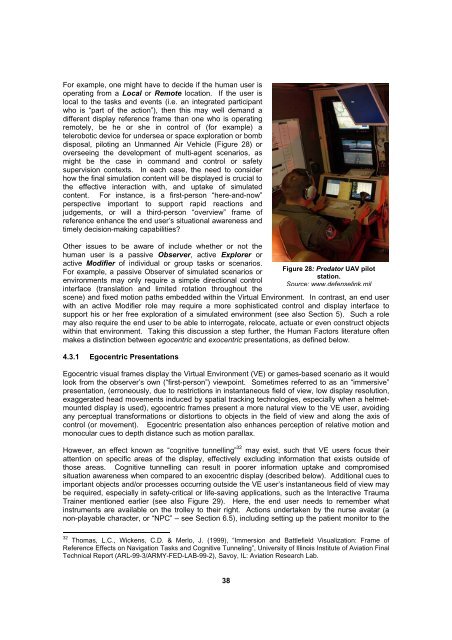Human Factors Guidelines for Interactive 3D and Games-Based ...
Human Factors Guidelines for Interactive 3D and Games-Based ...
Human Factors Guidelines for Interactive 3D and Games-Based ...
Create successful ePaper yourself
Turn your PDF publications into a flip-book with our unique Google optimized e-Paper software.
For example, one might have to decide if the human user is<br />
operating from a Local or Remote location. If the user is<br />
local to the tasks <strong>and</strong> events (i.e. an integrated participant<br />
who is “part of the action”), then this may well dem<strong>and</strong> a<br />
different display reference frame than one who is operating<br />
remotely, be he or she in control of (<strong>for</strong> example) a<br />
telerobotic device <strong>for</strong> undersea or space exploration or bomb<br />
disposal, piloting an Unmanned Air Vehicle (Figure 28) or<br />
overseeing the development of multi-agent scenarios, as<br />
might be the case in comm<strong>and</strong> <strong>and</strong> control or safety<br />
supervision contexts. In each case, the need to consider<br />
how the final simulation content will be displayed is crucial to<br />
the effective interaction with, <strong>and</strong> uptake of simulated<br />
content. For instance, is a first-person “here-<strong>and</strong>-now”<br />
perspective important to support rapid reactions <strong>and</strong><br />
judgements, or will a third-person “overview” frame of<br />
reference enhance the end user’s situational awareness <strong>and</strong><br />
timely decision-making capabilities?<br />
Other issues to be aware of include whether or not the<br />
human user is a passive Observer, active Explorer or<br />
active Modifier of individual or group tasks or scenarios.<br />
For example, a passive Observer of simulated scenarios or<br />
environments may only require a simple directional control<br />
interface (translation <strong>and</strong> limited rotation throughout the<br />
38<br />
Figure 28: Predator UAV pilot<br />
station.<br />
Source: www.defenselink.mil<br />
scene) <strong>and</strong> fixed motion paths embedded within the Virtual Environment. In contrast, an end user<br />
with an active Modifier role may require a more sophisticated control <strong>and</strong> display interface to<br />
support his or her free exploration of a simulated environment (see also Section 5). Such a role<br />
may also require the end user to be able to interrogate, relocate, actuate or even construct objects<br />
within that environment. Taking this discussion a step further, the <strong>Human</strong> <strong>Factors</strong> literature often<br />
makes a distinction between egocentric <strong>and</strong> exocentric presentations, as defined below.<br />
4.3.1 Egocentric Presentations<br />
Egocentric visual frames display the Virtual Environment (VE) or games-based scenario as it would<br />
look from the observer’s own (“first-person”) viewpoint. Sometimes referred to as an “immersive”<br />
presentation, (erroneously, due to restrictions in instantaneous field of view, low display resolution,<br />
exaggerated head movements induced by spatial tracking technologies, especially when a helmetmounted<br />
display is used), egocentric frames present a more natural view to the VE user, avoiding<br />
any perceptual trans<strong>for</strong>mations or distortions to objects in the field of view <strong>and</strong> along the axis of<br />
control (or movement). Egocentric presentation also enhances perception of relative motion <strong>and</strong><br />
monocular cues to depth distance such as motion parallax.<br />
However, an effect known as “cognitive tunnelling” 32 may exist, such that VE users focus their<br />
attention on specific areas of the display, effectively excluding in<strong>for</strong>mation that exists outside of<br />
those areas. Cognitive tunnelling can result in poorer in<strong>for</strong>mation uptake <strong>and</strong> compromised<br />
situation awareness when compared to an exocentric display (described below). Additional cues to<br />
important objects <strong>and</strong>/or processes occurring outside the VE user’s instantaneous field of view may<br />
be required, especially in safety-critical or life-saving applications, such as the <strong>Interactive</strong> Trauma<br />
Trainer mentioned earlier (see also Figure 29). Here, the end user needs to remember what<br />
instruments are available on the trolley to their right. Actions undertaken by the nurse avatar (a<br />
non-playable character, or “NPC” – see Section 6.5), including setting up the patient monitor to the<br />
32 Thomas, L.C., Wickens, C.D. & Merlo, J. (1999), “Immersion <strong>and</strong> Battlefield Visualization: Frame of<br />
Reference Effects on Navigation Tasks <strong>and</strong> Cognitive Tunneling”, University of Illinois Institute of Aviation Final<br />
Technical Report (ARL-99-3/ARMY-FED-LAB-99-2), Savoy, IL: Aviation Research Lab.







![Benyamin Asadipour-Farsani [EngD Conference abstract]](https://img.yumpu.com/51622940/1/184x260/benyamin-asadipour-farsani-engd-conference-abstract.jpg?quality=85)









